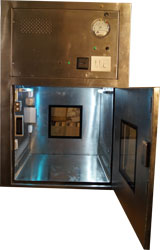Exploring the Vital Role of Static and Dynamic Pass-Through Boxes in Cleanroom Environments
Cleanrooms are critical environments in various industries such as pharmaceuticals, electronics, biotechnology, and healthcare, where even the smallest particles can lead to product contamination and compromised research. Maintaining the integrity of these controlled environments is paramount, and one essential component in achieving this is the pass-through box, often referred to as a pass box or pass-through chamber. In this blog, we'll delve into the concepts of static and dynamic pass-through boxes, their functions, and their significance in cleanroom operations.
The Importance of Contamination Control
Before we dive into the specifics of pass-through boxes, it's crucial to understand the importance of contamination control in cleanrooms. Contamination can originate from various sources, including personnel, equipment, and materials. To mitigate this risk, cleanrooms are designed with advanced air filtration systems and strict protocols for gowning, disinfection, and handling of materials.
Pass-Through Boxes: A Barrier Against Contamination
Pass-through boxes act as a crucial barrier between different cleanroom areas or between cleanroom and non-cleanroom spaces. These devices allow for the transfer of materials and equipment while minimizing the risk of contamination. There are two main types of pass-through boxes: static and dynamic.
Static Pass-Through Box
Static pass-through boxes are simple, non-mechanical systems designed for one-way material transfer. They feature doors on both sides, with one side facing the cleanroom and the other side facing a non-cleanroom area. Personnel place materials or items into the cleanroom side, and the items are accessed from the other side without compromising the cleanroom environment.
Key features of static pass-through boxes:
One-way transfer
Non-mechanical
Minimizes air exchange between spaces
Reduces the risk of particle contamination
Typically used for non-hazardous materials
Static pass-through boxes are ideal for transferring non-hazardous materials and equipment between cleanroom and non-cleanroom areas, helping maintain the cleanroom's controlled environment.
Dynamic Pass-Through Box
Dynamic pass-through boxes are more advanced systems that incorporate mechanical features to provide two-way transfer of materials and items. These boxes have a higher level of automation and are designed for more critical applications where maintaining a controlled environment is essential.
Key features of dynamic pass-through boxes:
Two-way transfer
Mechanical interlocking system
High efficiency in reducing contamination risks
Suitable for hazardous materials, chemicals, and critical applications
Advanced air filtration and sterilization options
Dynamic pass-through boxes are commonly used in cleanrooms that handle hazardous materials, pharmaceuticals, and research facilities where strict contamination control is crucial. Their advanced features ensure a higher level of cleanliness and safety.
Benefits of Using Pass-Through Boxes
Both static and dynamic pass-through boxes offer several benefits, such as:
Contamination Control: Pass-through boxes prevent contaminants from entering or exiting the cleanroom environment during material transfer, ensuring the cleanroom's integrity.
Time and Cost Efficiency: Pass-through boxes save time and reduce the need for personnel to enter and exit the cleanroom for material transfer, improving workflow efficiency.
Safety: Dynamic pass-through boxes, in particular, are crucial for handling hazardous materials and chemicals, enhancing the safety of cleanroom operations.
Compliance: Pass-through boxes help cleanrooms meet regulatory requirements and maintain high standards of cleanliness and contamination control.
In Conclusion
Static and dynamic pass-through boxes are essential components of cleanroom environments, providing a controlled and secure means of transferring materials and equipment while minimizing contamination risks. Their use contributes to the overall efficiency, safety, and integrity of cleanroom operations. Whether you are working with non-hazardous materials or dealing with critical applications, pass-through boxes are a critical tool in maintaining the highest levels of contamination control in your cleanroom environment.


Comments
Post a Comment